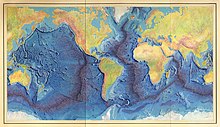Mapping (cartography)

When mapping in the strict sense of the graphical representation of objects and situations will surface in maps or plans referred. The individual measuring points mostly come from a terrestrial survey , from GPS measurements or from satellite or aerial photogrammetry . The standards are based on the intended use and range
- For terrestrial surveys and vegetation maps from 1: 50,000 (e.g. from aerial photos ) to around 1: 5,000 ( base maps )
- for technical objects and structures from about 1: 2000 to 1: 500, for detailed plans also up to 1: 100.
In order to be able to enter the geodetically or photogrammetrically measured points on the map or a floor plan , their coordinates (e.g. Gauß-Krüger coordinates x, y) must first be calculated. Today this is mostly done in the automatic flow of data from the total station or from the evaluation device ( stereo comparator ) via the computer to the digital mapping device or plotter . Up until around 1970, this required a series of manual intermediate steps, the last of which were as follows:
- Plot of the [x / y] values with a coordinate graph
- or transporter (protractor + ruler) and the Kartiernadel
- the entry of the point number
- and the connection of points that belong together (terrain lines, bodies of water, roadsides, buildings, borders, etc.) using lineaments and curves.
“Mapping in the broader sense” includes i. A. also the recording or measurement of the points and the determination of their object class and other properties. In addition to theodolite measurements, satellite and aerial photos or GPS, some recordings are also made with the measuring table , with the gradient meter , the geological compass and other special devices. The measuring points are usually entered on site in a field sketch that also contains any running and blocking dimensions . For the allocation and control of the points during the subsequent mapping on the drawing carrier (foil, paper, cardboard), sketches and blocked dimensions are quite helpful.
The drawing up of the measurement points on the actual map base and the entry of the associated signatures is i. A. is no longer counted as part of the mapping, but is the subject of the cartographic processing of the entire work.
See also
- Mapping (geosciences) - applied cartography of the specialist disciplines as a survey in the field (map recording)
literature
- Eduard Imhof: Thematic cartography. Walter de Gruyter, Berlin / New York 1972.
- Max Eckert-Greifendorff: Cartography. Their tasks and significance for contemporary culture. Walter de Gruyter & Co, Berlin 1939.
- Günter Hake, Dietmar Grünreich, Liqiu Meng: Cartography. Visualization of space-time information. 8th edition. Walter de Gruyter, Berlin / New York 2002, ISBN 3-11-016404-3 .
Web links
- Lexicon of Cartography and Geomatics (accessed on January 14, 2016)
- Thematic cartography (accessed January 14, 2016)